Extending the Math in Picture Books
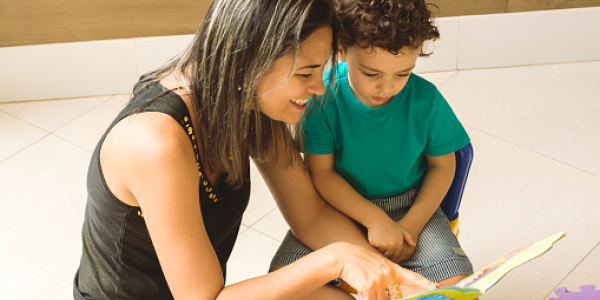
You are here
José carries a book to Ms. Keller and hands it to her as he crawls into her lap. After settling in, he looks up and says, “I’m ready to read!” Returning his gaze to the book, José listens as Ms. Keller begins reading.
Ms. Keller: One red ball. Look how round the ball in this picture is.
José: It can roll and bounce.
Ms. Keller: You’re right, balls are spheres that can roll back and forth. How about these two round bike tires?
José: They are the same size. Why are there lines in the tires?
Ms. Keller: Those are straight, metal spokes. They help make sure the bike tires roll evenly instead of wobbly. (She turns the page.) Three slides.
José (counting): One, two, three.
Ms. Keller: Yes, there are three slides. Look how each one is different. What do you notice about the slides?
José: This one is the biggest, and this one is the smallest.
Ms. Keller: Yes, you are right. I wonder why they are different sizes?
José: Maybe the bigger one is for the bigger children.
Ms. Keller: Good problem solving, José! The bigger children would be able to climb these bigger steps on the taller slide.
José (counting): One, two, three, five.
Ms. Keller: That’s a lot of steps. Let’s count them together: one, two, three, four, five. So how many stairs does the taller slide have?
José: Five.
Ms. Keller: This page has umbrellas. I wonder if there are enough umbrellas for all the children on this page? (The two begin counting.)
José: One, two, three, four umbrellas. (He points to the characters.) There is one for him, one for her, one for her, and one for him.
Ms. Keller: Yes, four umbrellas, and four children. It’s great that nobody will get wet when it rains.
José: This umbrella looks like mine. It is red and blue.
Ms. Keller: Yes, and those colors make a pattern—blue, then red; blue, then red. What patterns do you see on the other umbrellas?
José and his teacher are engaged in shared reading, or the intentional back-and-forth interaction that happens when an adult reads to a child, modeling the enjoyment of reading while promoting language skills and general knowledge. Shared reading can occur between a child and a teacher, family member, caregiver, or librarian. It may occur with books of all kinds, from fairytales to superhero comic books. (For more information on shared reading, see “The Nature and Benefits of Shared Reading” below.)
While shared reading clearly supports literacy development, it also provides an opportunity to promote early math skills and to help teachers convey that math is a part of life and for everyone. This is true whether a book focuses primarily on math concepts or concepts from other content areas (Davidse, de Jong, & Bus 2013). Consider the instances of mathematics Ms. Keller shared with José: The book they read was a counting book, so it is no surprise that Ms. Keller invited José to join in counting or that José counted on his own. But Ms. Keller also discussed shapes, modeled measuring and data analysis, and asked José to look for patterns. She encouraged him to use math in conversation and to think mathematically by asking him to name shapes, describe their attributes, and compare objects’ sizes. She also made certain to use math meaningfully: instead of simply counting umbrellas, Ms. Keller noticed an opportunity to use counting to solve a problem when she asked, “Are there enough umbrellas for all the children?” All this math from just the first four pages of a counting book!
All types of books present opportunities to encourage early math thinking. Because many teachers regularly engage in shared reading, finding and extending the math in picture books and other texts provide a readily available opportunity to expose children to early math concepts (Anderson, Anderson, & Shapiro 2005; Hojnoski, Columba, & Polignano 2014; van den Huevel-Panhuizen, Elia, & Robitzsch 2016). In this article, we discuss the benefits of engaging children in math learning through shared reading, then we outline strategies that early childhood educators can use to extend the math during shared reading of counting books, shape books, and books that may not be obviously mathematical. Finally, we end with some guidelines for choosing picture books that depict math in positive and developmentally appropriate ways for young children.
The Nature and Benefits of Shared Reading
Shared reading is the intentional, back-and-forth interaction that occurs when adults read to children. In early childhood settings, shared reading involves a teacher and one or more children. How the interactions unfold depends on the teacher, the children involved, the teacher’s or children’s social and cultural backgrounds, the book they are reading together, or a combination of these influences. For example,
- Do teachers invite children to talk about the story being read? If so, when do they invite children’s comments?
- Do children engage readily with the adult reader, or do they listen quietly?
- How much do the children and teacher elaborate when describing a book’s illustrations?
Cultural preferences may add to these differences; for instance, Latino/a caregivers tend to take on a storyteller role and richly describe the events in the story, whereas European American adults tend to co-construct the story alongside the child (e.g., Melzi & Caspe 2005).
Shared reading across classrooms will reflect all of these differences despite the intentionality underlying the practice. Some teachers will elaborate on the events in a book, and others may make fewer comments while inviting children to share their own observations. Still other teachers may stick to a story’s text, avoid elaborations, and help draw children into the author’s intended story experience.
Fortunately, children’s language development may benefit from a variety of shared reading styles: gains in children’s language development and school readiness are among the benefits associated with shared reading (Whitehurst et al. 1994).
Encouraging Shared Reading with Families
The benefits of shared reading are not limited to the classroom, based on reports that many families in the US engage in shared reading quite frequently (Senechal 2006; Barnes & Puccioni 2017; Scholastic 2019). In a nationally representative sample of over 7,500 families in the US, 50 percent of parents and guardians reported reading to their children every day, another 38 percent reported reading some days each week, and 10 percent reported not reading regularly with their children (Yarosz & Barnett 2001). In a smaller but more recent representative sample of US families, 37 percent reported reading to their children every day, another 61 percent reported reading some days each week, and only 2 percent reported not reading regularly with their children (Barnes & Puccioni 2017).
Because children learn vocabulary from the words they hear, exposing them to the rich and diverse vocabulary in picture books helps them learn words they may not otherwise learn. Families’ language during shared reading and the text in picture books are more diverse, involve longer sentences, and have a richer variety of words compared to the language families use in their everyday conversations with children (Montag, Jones, & Smith 2015; Demir-Lira et al. 2019). This is especially the case when a book has high-quality illustrations because illustrations can initiate dialogue (Anderson, Anderson, & Shapiro 2005).
For these reasons, teachers may want to encourage families to engage in shared reading at home, provided such encouragement is consistent with their routines and sensitive to cultural variations in book sharing practices. Teachers may avoid assumptions about at-home shared reading practices by inviting families to share information on their favorite at-home routines and interests.
Promoting Early Math Through Shared Reading
Research shows that children who regularly engage in shared reading are more likely to have stronger reading comprehension, an internal motivation to read, and a larger receptive vocabulary compared to their peers with fewer reading experiences (Demir-Lira et al. 2019). In the opening vignette, José not only had an opportunity to notice a variety of mathematical properties, he was also exposed to the words used to convey those properties. This opportunity is valuable because building children’s mathematics vocabulary seems to support their mathematical thinking (Purpura & Reid 2016; Chan, Sera, & Mazzocco, in press). For example, increasing children’s exposure to quantitative phrases like more than or less than or to spatial language like above or behind helps support their thinking about comparing or adding numbers and their knowledge of objects in space.
Even if children already have these mathematics-related words in their vocabulary, encountering and engaging with math language in books reinforce their knowledge and give them an opportunity to hear or practice using the words in a new context. These repeated experiences are linked to increases in children’s math knowledge and may later extend to more advanced math concepts, such as early fraction words and mathematical symbols (Hassinger-Das, Jordan, & Dyson 2015).
Promoting mathematical thinking in preschool may give children a learning advantage by supporting their school readiness and later mathematics achievement (Claessens & Engel 2013; Rittle-Johnson et al. 2017). It is important that teachers look for opportunities to promote this thinking because math learning opportunities do not occur in the preschool classroom as frequently as literacy learning opportunities (Farran et al. 2017). In a study of preschool classrooms in three countries (including the United States), researchers found, on average, little focus on math throughout the preschool day (Coelho et al. 2021). Their observations of 168 US classrooms revealed that an average of 6 percent of activities focused on math (though this ranged from 0 percent to 14 percent across classrooms). In contrast, the average for activities targeting literacy was 15 percent (with a range of 4 percent to 32 percent across classrooms).
Revealing Math Intentionally
Despite the fact that shared reading occurs in many early childhood education settings, the math in picture books and other texts is not automatically revealed to children or noticed by adults. In fact, teachers may not realize that picture books present opportunities for math learning. Based on a survey of preschool educators, researchers found that they reported having fewer math picture books than all other types of books and that 11 percent did not consider the classroom library a space for math learning (Stites et al. 2021). If teachers recognize that picture books are avenues for math exploration, they may be more likely to encourage it by intentionally drawing attention to, or asking questions about, math-relevant details. They can do this by noticing examples of math in a book’s illustrations and plot (as described in the following sections) and by making comments or asking questions that promote understanding that math is meaningful.
When discussing math during shared reading, it is important to avoid assumptions about what children can or cannot do and instead provide opportunities to strengthen their existing skills and help them build new ones. For example, researchers in one study found that when faced with sets of two, six, and 10 items pictured in a counting book, adults (in this case, parents) were most likely to count the set of six with their infant children (Goldstein, Cole, & Cordes 2016) and less likely to count the much smaller or larger sets. The researchers speculated that adults assumed their children could easily count the smaller sets and that the larger sets were too complex. Decisions such as these reduce children’s opportunities to practice smaller set counting and prevent them from being exposed to the higher-level skills they will eventually need to achieve.
The following are some suggestions for how to intentionally reveal the math in different types of picture books.
Counting Books
Counting books provide a natural way to engage children in math content during shared reading. Although the structure of counting books may vary from a book with no storyline to one with an elaborate narrative, they all feature numbers and focus on counting.
Typically, adults make more numerical statements while reading counting books to children than they do when reading noncounting books. This is particularly true when elaborating on a counting book’s text or illustrations (Goldstein, Cole, & Cordes 2016). However, adults might not actually count the sets of items when reading these books. Instead, they may simply label the set size or ask the child to count or label (Mix et al. 2012).
It is important to be intentional about helping a child develop the counting sequence by demonstrating how to count a set and by scaffolding how to count if a child’s counting skills are still emerging. For example, in the opening vignette, José spontaneously counted some items, but he occasionally made errors when counting aloud beyond 3. Ms. Keller invited him to count the five steps of the tall ladder with her. After José counted the three slides, reciting “one, two, three,” Ms. Keller added, “There are three slides.” Repeated exposure to this kind of repetition may help José learn that the last number counted (in this case, 3) represents the total number of slides. Such modeling and encouragement help children gradually expand their counting sequence knowledge and learn what each number word means.
Because the characteristics of counting books vary so widely (Ward et al. 2017), educators must pay close attention to how clear they are to the young reader. Teachers should ask themselves
- Do numbers appear in a sequential ascending order, out of order, or backwards?
- Is it clear to what the number displayed refers (Ward et al. 2017)? For example, the number 6 may appear on a page that features six bananas, four bowls, and two chairs.
- Are the objects to be counted arranged linearly (making them easier to count), or do they overlap or appear scattered across a page (making them harder to keep track of)?
- Do the illustrations allow children to find all of the items to be counted and to keep track of what has already been counted?
If illustrations are too abstract or the objects shown in them are close together and difficult to count, teachers can support children by using real, concrete materials to count alongside the story. Ms. Keller could do this by giving José three pencils to count, the same number as the three slides.
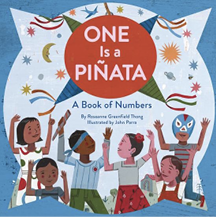 One Is a Piñata: A Book of Numbers. By Roseanne Greenfield Thong. Illus. by John Parra. 2019. San Francisco, CA: Chronicle Books.
One Is a Piñata: A Book of Numbers. By Roseanne Greenfield Thong. Illus. by John Parra. 2019. San Francisco, CA: Chronicle Books.
In this counting book, the text shows the numbers 1 to 10 in three ways: using the written numeral, the English number word, and the Spanish number word. Children can practice counting the corresponding number of items in the illustrations, which feature objects that can be found in Central America such as frutas and maracas.
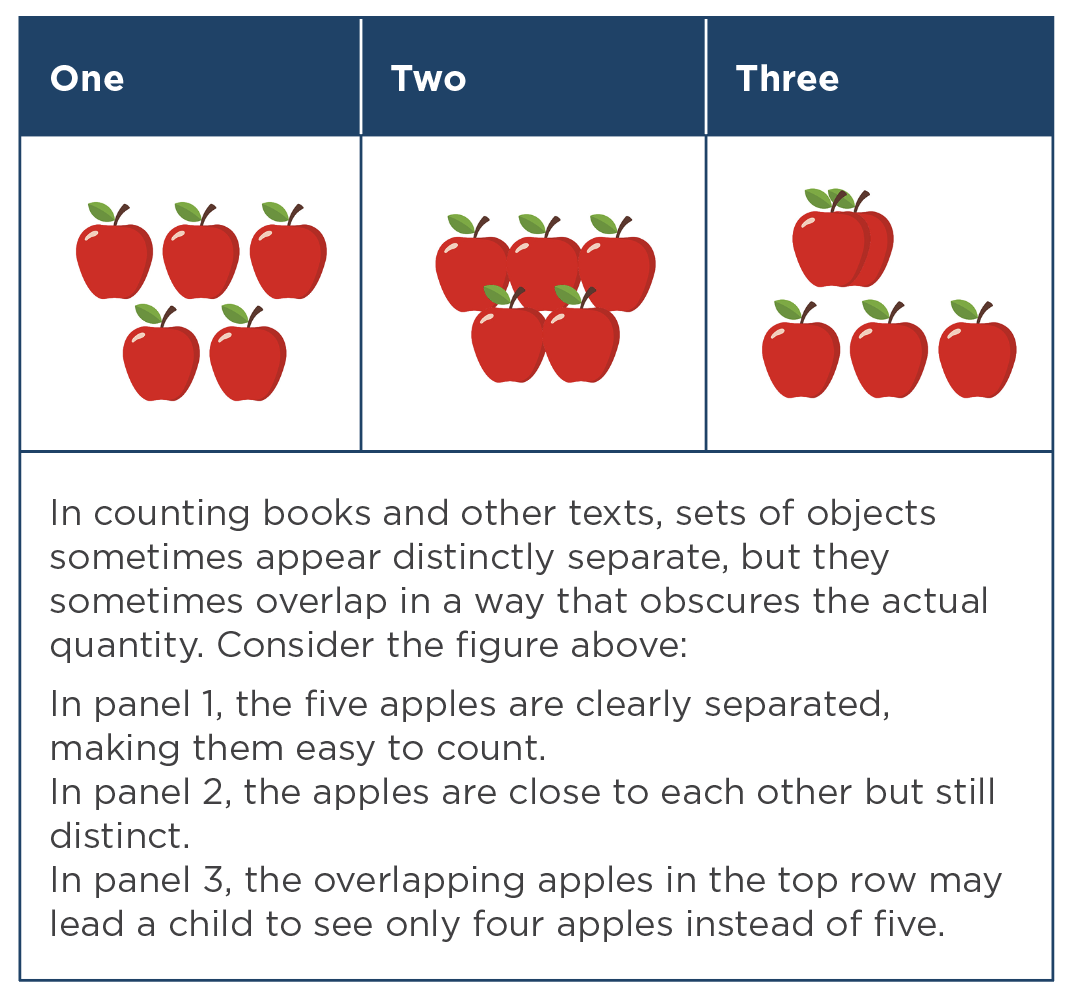
Shape Books
These picture books can be a powerful tool to engage children in an exploration of shapes. They also present opportunities to discuss geometry principles, whether or not they have an accompanying story. Yet during reading and other activities, teachers frequently focus on labeling shapes without exploring their properties, parts, sizes, and orientations (Engel, Claessens, & Finch 2013).
Educators can remedy this missed opportunity by discussing, for example, the number of sides and corners a shape has and by noticing which sides are long and which sides are short. This kind of shape exploration can lead to a discussion about how some shapes look different even when they have the same defining features, such as when comparing a skinny, long triangle with a short, wide triangle. (Both have three straight sides and three vertices.) Teachers can point out these kinds of similarities and differences among shapes; they can also rotate a book to explore whether a shape changes or remains the same.
Although shape books can support children’s geometric thinking, the type and accuracy of the shapes depicted may vary. Many books show a small set of common shapes, but far fewer books include less common shapes like hexagons and pentagons (Resnick et al. 2016). When children are exposed to only the most familiar shapes, such as equilateral triangles oriented horizontally, this limits their understanding. Perhaps more troubling, 76 percent of the books Nurnberger-Haag (2017) evaluated contained at least one inaccurate or misleading portrayal or description of a shape. In one book, for instance, a square was correctly labeled, and a tilted square was labeled a diamond. Use of the informal term (diamond) rather than the mathematical term (rhombus) is only part of the misleading information in this example. The more significant concern is the implication that a shape changes based on its orientation. The book could have conveyed that a square remains a square, even when tilted.
When choosing shape books to read with children, educators should look for books that highlight a variety of shapes in various sizes and orientations. Any inaccuracies should be pointed out and discussed. In the case of the rotated square, the teacher could explain, “This shape is still a square because it has four straight sides that are the same length. See, all four sides are the same length, so it is still a square. Sometimes people call a tilted square a diamond, but this diamond is still a square.” In this way, even inaccurate images and text can be used to support math teaching and learning.

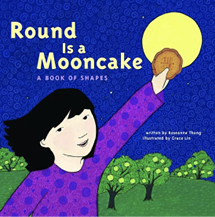 Round Is a Mooncake: A Book of Shapes. By Roseanne Thong and Grace Lin. 2014. San Francisco, CA: Chronicle Books.
Round Is a Mooncake: A Book of Shapes. By Roseanne Thong and Grace Lin. 2014. San Francisco, CA: Chronicle Books.
Children can discover shapes alongside the characters on each page of this book. There are round lanterns, square radish cakes, and rectangular sacks of rice. During shared reading, children can learn about both the names and characteristics of these differently shaped items, many of which are connected to Chinese culture.
Other Types of Picture Books
The illustrations in picture books present an opportunity for math conversations because they feature different characters and objects of varied numbers, sizes, and shapes. Teachers can look for opportunities to point out these concepts and engage children in math conversations even when math is not the primary focus of the story. For example, children must draw on their knowledge of size relations when a teacher says, “The cow is taller than the dog. What animal is shorter than a dog?” They must begin thinking of numerical operations when a teacher asks, “How many apples will Lizzie have left if she eats one?” They are introduced to early data concepts of comparing and contrasting when asked, “All of the animals chose to have apple or bread for a snack; did more animals choose the apple, or did more animals choose the bread?”
Teachers can also use books to support children’s mathematical learning beyond counting and identifying shapes. They can use picture books to introduce concepts like addition and subtraction, measurement, spatial orientation, and patterning and sorting—even before these concepts are formally taught. One way to do this is by asking questions that challenge children to reinforce existing skills, strengthen emerging skills, and attain new skills (Deshmukh et al. 2019). “Finding the Math in a Picture” below provides examples of how to do this.
Books can be used again and again as children gain more math knowledge. A title initially used to help a child understand how and why to count can be revisited later as a way to practice counting skills. As teachers read and reread the same books, they can gradually point out more complex math concepts (such as addition, measurement, or data analysis) as children ask new questions or show an understanding of the concepts discussed during previous readings.

Choosing Math Picture Books
Although picture books can be a powerful tool to promote children’s math learning, not all books may be equally effective. If you have an opportunity to select books for shared reading or a classroom library, evaluate them for positive views of math (Ginsburg & Uscianowski 2017). Ask yourself the following questions:
- Do the books include illustrations and text that accurately demonstrate math, and do these illustrations and text appear in a clear manner that is not distracting or confusing?
- Do the text, math, and pictures align? For example, if the text states, “Shawn traveled very far to get to his grandma’s house,” yet the illustration shows Shawn walking from a car in a driveway to the door of a house, children may inaccurately interpret the spatial term far.
-
If you notice incorrect or potentially confusing examples, can you address them? For example,
- In the instance above, a teacher could say: “Here Shawn is just walking up from the car to his grandma’s house, but before he got out of the car, he and his father drove all the way from another city! It took them all day to drive to his grandma’s house.”
- If a counting book features the numeral 5 next to a picture of six balls (one large and five small), count the six balls. Then specify that 5 is the number of small balls, and recount those.
- Do the books promote the idea that math is for everyone? A teacher’s collection of books should feature a diverse array of characters from different races, genders, cultures, and countries as well as nontraditional families and children with disabilities.
-
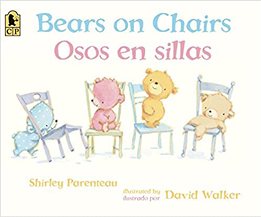 Bears on Chairs/Osos en Sillas. By Shirley Parenteau. Illus. by David Walker. 2018. Sommerville, MA: Candlewick Press.
Bears on Chairs/Osos en Sillas. By Shirley Parenteau. Illus. by David Walker. 2018. Sommerville, MA: Candlewick Press.
Four small bears fit perfectly on four small chairs until Big Brown Bear shows up. Then the bears must work together to find a way for all five of them to share the four chairs. Although this book was not explicitly written to teach math, teachers and children can count and compare the number of bears and chairs, discuss how to fairly share the four chairs among five bears, and talk about the size relationships between the taller and wider Big Brown Bear and the smaller bears.
Finding the Math in a Picture
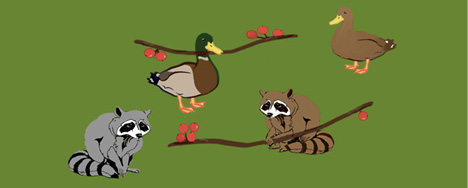
If a teacher was reading a story and came to this picture, they could promote math thinking in multiple areas by posing a variety of questions and comments.
Counting
- How many ducks are on this page? How many raccoons are there?
- How many animals are on this page altogether?
- Do all the animals have the same number of legs?
Operations
- One duck has a stick. The stick has three berries on one side and two berries on the other. I wonder how many berries the duck has altogether?
- If the duck gives one of its berries to each of the other animals, how many berries will the duck have left?
- How can we tell which animal has the most berries?
Spatial Relations and Shapes
- Are the ducks in front of or behind the raccoons?
- I wonder if the sticks can roll on the ground. (This may prompt a discussion that the sticks are not straight.)
Measurement and Data
- Which stick looks longer? How can we know for sure?
- Does the raccoon have more berries on the left side or on the right side?
- Which animal has the most berries? (It is okay to ask children to compare two quantities even when they are the same.)
- If each of the four animals wants to have three berries for dinner, do they have enough berries? (This prompt leads to a problem that can be solved in several different ways. Teachers can use this type of questioning to observe individual children’s approaches to problem solving or to model problem solving themselves.)
Making Math Meaningful
This collection of questions and comments is an example of ways to address different domains of math. However, in isolation, each question may not interest a child listening to the story. The most engaging questions are meaningfully tied to the story’s context or to something else happening in your classroom. For example, the question about the animals sharing berries equally may be especially meaningful if the story concerns animals collaboratively looking for food or gathering to share a meal.
Conclusion
Providing early math learning opportunities for preschoolers builds a foundation for their later mathematical skills and achievement. Although young children need a variety of opportunities to develop their mathematical thinking, intentionally revealing and extending the math in a variety of texts provide an enjoyable and readily available opportunity to bring more math discourse and concepts into the preschool setting. This practice also helps reveal the math of everyday life, helping children understand that math is a useful and natural part of their lives.
Suggested Math Picture Books
Shapes and Spatial Reasoning
- Marta! Big and Small, by Jen Arena, illus. by Angela Dominguez (2016)
- Usha and the Big Digger, by Amitha Jagannath Knight, illus. by Sandhya Prabhat (2021)
- Look, Grandma! Ni, Elisi!, by Art Coulson, illus. by Madelyn Goodnight (2021)
- What Will Fit?, by Grace Lin (2020)
- Circle! Sphere!, by Grace Lin (2020)
- Round Is a Tortilla: A Book of Shapes, by Roseanne Thong, illus. by John Parra (2015)
- Round Is a Mooncake: A Book of Shapes by Roseanne Thong, illus. by Grace Lin (2014)
Numbers and Counting
- 10 Gulab Jamuns: Counting with an Indian Sweet Treat, by Sandhya Acharya, illus. by Vanessa Alexandre (2017)
- Baby Goes to Market, by Atinuke, illus. by Angela Brooksbank (2017)
- Lia and Luis: Who Has More?, by Ana Crespo, illus. by Giovana Medeiros (2020)
- Feast for 10, by Cathryn Falwell (2003)
- I Know Numbers!, by Taro Gomi (2017)
- Bird Count, by Susan Edwards Richmond, illus. by Stephanie Fizer Coleman (2019)
- One Is a Piñata: A Book of Numbers, by Roseanne Greenfield Thong, illus. by John Parra (2019)
- Luna’s Yum Yum Dim Sum, by Natasha Yim, illus. by Violet Kim (2020)
Photographs: © Getty Images
Copyright © 2022 by the National Association for the Education of Young Children. See Permissions and Reprints online at NAEYC.org/resources/permissions.
References
Anderson, A., J. Anderson, & J. Shapiro. 2005. “Supporting Multiple Literacies: Parents’ and Children’s Mathematical Talk within Storybook Reading.” Mathematics Education Research Journal 16 (3): 5–26.
Barnes, E., & J. Puccioni. 2017. “Shared Book Reading and Preschool Children’s Academic Achievement: Evidence from the Early Childhood Longitudinal Study—Birth Cohort.” Infant and Child Development 26 (6).
Chan, J.Y.C., M.D. Sera, & M.M. Mazzocco. “Relational Language Influences Young Children’s Number Relation Skills.” Child Development, in press.
Claessens, A., & M. Engel. 2013. “How Important Is Where You Start? Early Mathematics Knowledge and Later School Success.” Teachers College Record 115 (6): 1–29.
Coelho, V., F. Åström, K. Nesbitt, M. Sjöman, D. Farran, E. Björck-Åkesson, C. Christopher, M. Granlund, L. Almqvist, C. Grande, & A.I. Pinto. 2021. “Preschool Practices in Sweden, Portugal, and the United States.” Early Childhood Research Quarterly 55: 79–96.
Davidse, N.J., M.T. De Jong, & A.G. Bus. 2013. “Explaining Common Variance Shared by Early Numeracy and Literacy.” Reading and Writing 27 (4): 631–648.
Demir-Lira, Ö.E., L.R. Applebaum, S. Goldin-Meadow, & S.C. Levine. 2019. “Parents’ Early Book Reading to Children: Relation to Children’s Later Language and Literacy Outcomes Controlling for Other Parent Language Input.” Developmental Science 22 (3).
Deshmukh, R.S., T.A. Zucker, S.R. Tambyraja, J.M. Pentimonti, R.P. Bowles, & L.M. Justice. 2019.“Teachers’ Use of Questions During Shared Book Reading: Relations to Child Responses.” Early Childhood Research Quarterly 49 (4): 59–68.
Engel, M., A. Claessens, & M.A. Finch. 2013. “Teaching Students What They Already Know? The (Mis)Alignment Between Mathematics Instructional Content and Student Knowledge in Kindergarten.” Educational Evaluation and Policy Analysis 35 (2): 157–178.
Farran, D.C., D. Meador, C. Christopher, K.T. Nesbitt, & L.E. Bilbrey. 2017. “Data-Driven Improvement in Prekindergarten Classrooms: Report from a Partnership in an Urban District.” Child Development 88 (5): 1466–1479.
Ginsburg, H.P., & C. Uscianowski. 2017. “Development and Research in Early Math Education.” Development and Research in Early Math Education (blog). DREME https://dreme.stanford.edu/sites/g/files/sbiybj9961/f/picture_book_rating_guide_parents_v12.pdf
Goldstein, A., T. Cole, & S. Cordes. 2016. “How Parents Read Counting Books and Non-Numerical Books to Their Preverbal Infants: An Observational Study.” Frontiers in Psychology 7.
Hassinger-Das, B., N.C. Jordan, & N. Dyson. 2015. “Reading Stories to Learn Math.” The Elementary School Journal 116 (2): 242–264.
Hojnoski, R.L., H.L. Columba, & J. Polignano. 2014. “Embedding Mathematical Dialogue in Parent–Child Shared Book Reading: A Preliminary Investigation.” Early Education and Development 25 (4): 469–92.
Melzi, G., & M. Caspe. 2005. “Variations in Maternal Narrative Styles During Book Reading Interactions.” Narrative Inquiry 15 (1): 101–125.
Mix, K.S., C.M. Sandhofer, J.A. Moore, & C. Russell. 2012. “Acquisition of the Cardinal Word Principle: The Role of Input.” Early Childhood Research Quarterly 27 (2): 274–283.
Montag, J.L., M.N. Jones, & L.B. Smith. 2015. “The Words Children Hear.” Psychological Science 26 (9): 1489–1496.
Nurnberger-Haag, J. 2017. “A Cautionary Tale: How Children’s Books (Mis)Teach Shapes.” Early Education and Development 28 (4): 415–440.
Purpura, D.J., & E.E. Reid. 2016. “Mathematics and Language: Individual and Group Differences in Mathematical Language Skills in Young Children.” Early Childhood Research Quarterly 36: 259–268.
Resnick, I., B.N. Verdine, R. Golinkoff, & K. Hirsh-Pasek. 2016. “Geometric Toys in the Attic? A Corpus Analysis of Early Exposure to Geometric Shapes.” Early Childhood Research Quarterly 36: 358–65.
Rittle-Johnson, B., E.R. Fyfe, K.G. Hofer, & D.C. Farran. 2017. “Early Math Trajectories: Low-Income Children's Mathematics Knowledge from Ages 4 to 11.” Child Development 88 (5): 1727–1742.
Scholastic, 2019. “The Rise of Read-Aloud.” In Scholastic Kids & Family Reading Report, 7th ed. Accessed on January 14, 2021. https://www.scholastic.com/readingreport/home.html
Senechal, M. 2006. “Testing the Home Literacy Model: Parent Involvement in Kindergarten Is Differentially Related to Grade 4 Reading Comprehension, Fluency, Spelling, and Reading for Pleasure.” Scientific Studies of Reading 10 (1): 59–87.
Stites, M.L., S. Sonnenschein, R. Dowling,, & B. Gay. 2021. “Mathematics Learning Opportunities in Preschool: Where Does the Classroom Library Fit in?” Early Education and Development 32 (1): 66–81.
van den Heuvel-Panhuizen, M., I. Elia, & A. Robitzsch. 2016. “Effects of Reading Picture Books on Kindergartners’ Mathematics Performance.” Educational Psychology 36 (2): 323–346.
Ward, J.M., M.M. Mazzocco, A.M. Bock, & N.A. Prokes. 2017. “Are Content and Structural Features of Counting Books Aligned with Research on Numeracy Development?” Early Childhood Research Quarterly 39: 47–63.
Whitehurst, G.J., D.S. Arnold, J.N. Epstein, A.L. Angell, M. Smith, & J.E. Fischel. 1994. “A Picture Book Reading Intervention in Day Care and Home for Children from Low-Income Families.” Developmental Psychology 30 (5): 679–689.
Yarosz, D.J., & W.S. Barnett. 2001. “Who Reads To Young Children?: Identifying Predictors of Family Reading Activities.” Reading Psychology 22 (1): 67–81.
Megan Onesti, MA, EdS, is a school psychologist currently working in SouthWest Metro Intermediate District in Shakopee, Minnesota. While in graduate school, Megan was involved in research on early math learning opportunities in both pre-K classrooms and shared reading as an affiliate member of the Development and Research in Early Math Education Network and the Early Math and Numeracy Lab.
Colleen Uscianowski, PhD, is an assistant professor of early childhood education at the University of Cincinnati in Cincinnati, Ohio, and an affiliate member of the Development and Research in Early Math Education Network. She conducts research on children’s mathematical thinking, teacher preparation, and the home math environment.
Michèle M. Mazzocco, PhD, is a professor of developmental psychology at the University of Minnesota, Institute of Child Development, where she directs the Early Math and Numeracy Lab. Michèle studies cognitive development, with a focus on numerical thinking in children and adults. She has also studied mathematical learning difficulties and disabilities. As a former licensed early childhood teacher, Michèle is interested in the application of this research to learning materials and learning environments. [email protected]